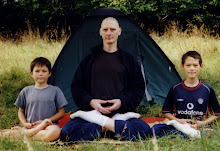SO-SO NO ZANMAI: Samadhi of the Ancestors
SO grandparent, ancestor, patriarch/matriarch
SO [repeated to suggest the one-to-one transmission through the lineage of ancestors]
NO [joining particle]
ZANMAI samadhi (rendered phonetically)
O [object particle]
TEKI rightful heir, legitimate successor
SHI succeed
TEKISHI SU to succeed as a rightful heir
SEYO [imperative] do it!
“Succeed as a rightful heir to the samadhi of the ancestors.”
There may be different kinds of samadhi and samadhi is described in Shobogenzo from various viewpoints, but what Master Dogen is indicating here is the samadhi of the ancestors of his lineage. That means the samadhi of accepting and using the self, as transmitted by the practice of sitting upright in the lotus posture.
The criterion of authenticity or legitimacy of transmission from ancestor to ancestor, Master Dogen tells us in Shobogenzo Bendowa, is just the samadhi of accepting and using the self.
The transmission of the samadhi of the ancestors is accomplished traditionally by teacher and student, father and son, or father and daughter, sitting together, upright in the lotus posture, enjoying together the samadhi of accepting and using the self.
The self means the whole self -- not the feeling body, not the thinking mind, and not the fucking autonomic nervous system, but the whole self realized as a unity in the integral act of sitting.
If the father remains immovably fixed in his view that the samadhi of accepting and using the self should be identified with balance of the parasympathetic and sympathetic branches of the autonomic nervous system, that is just the stubborn father’s stubborn failure to drop off a viewpoint to which he is wrongly and proudly attached. And if the stubborn son finds it difficult to stop reacting with anger to a terrible mistake made by the fearful father, following the mirror principle, because of his own wrong and proud attachment to a view, then maybe if the stubborn son furiously channels his energy into writing a blog like this one, some good may result in the end.
Hope my answers to your questions haven’t been too long-winded and convoluted, MT. The principle of “less is more” seemed to go out of the window. Anyway, thank you again for asking.


0 Comments:
Post a Comment
<< Home